María Denis plays the lead in the Italian melodrama Sissignora/Yes, Madam (1942) produced under the Fascist rule of Mussolini. The beautiful star was very successful during the 1930 and 1940s with these melodramas and her Telefoni Bianchi-films, the typical Italian society comedies.
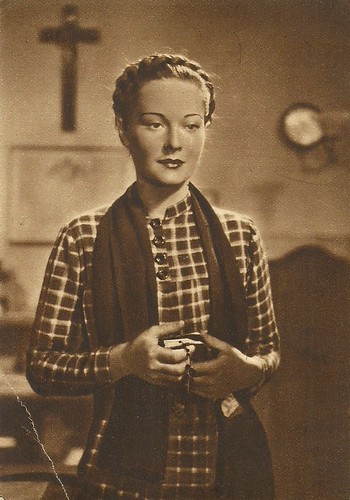
Italian postcard for Sissignora (Ferdinando Maria Poggioli, 1942), with María Denis.
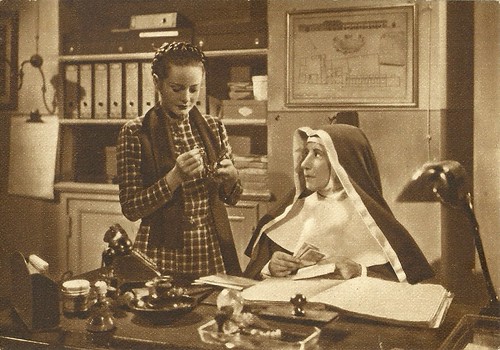
Italian postcard for Sissignora (Ferdinando Maria Poggioli, 1942), with María Denis and Anna Carena.
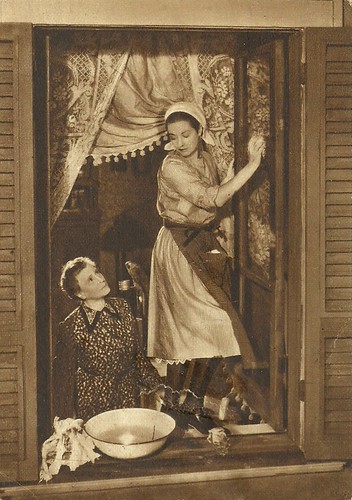
Italian postcard for Sissignora (Ferdinando Maria Poggioli, 1942), with María Denis and Emma or Irma Grammatica.
María Denis plays in Sissignora young Cristina Zunio. She is an orphan after the death of her only aunt.
Cristina needs work and asks sister Valeria (Rina Morelli) for help. She thus becomes a domestic with the two old ladies Robbiano (Emma and Irma Grammatica) who treat her with austerity and narrow-mindedness.
Then their nephew, the young sailor Vittorio (Leonardo Cortese), returns from a long cruise. The two young people fall in love, opposed by the two old spinsters who won't accept he ties himself to a 'maid'. So they fire her to get rid of her.
Cristina thus starts working for the Bracco-Rinaldi family, who pretend to be high society but are debt-ridden, and they send Cristina away without payment. Meanwhile Vittorio manages to find Cristina and the two decide to marry, so Cristina rejects a marriage offer by the shy Emilio (Elio Marcuzzo), a young man from her native village.
But then sister Valeria conspires with the Robbiani ladies and demands Cristina to break with Vittorio, so he sails away. Alone again, she gets a job at signora Valdata (Evi Maltagliati), widow with a small boy (Silverio Pesu), whose 'cousin' around proves to be her lover. When the child falls ill, they charge Cristina to take care of it, without telling her it suffers from chicken pox, so she is contaminated as well.
It will be Emilio to help her, but too late. When a doctor orders Cristina to recover in hospital she is already dying and soon she blows her last breath. Malice, narrow-mindedness, hypocrisy and egoism have caused the death of the girl.
The novel on which the screenplay of Sissignora/Yes, Madam is based is called La servetta di Masone. It was serialised in the Genovese weekly periodical Il Lavoro between January and March 1940 in which Maria Steno, the author, wrote under the nom-de-plume of Vittoria Greco. Emilio Cecchi and Alberto Lattuada wrote the screenplay.
The film was shot in the Fall and Winter of 1941 at the Cinecittà studios and on location in Genoa for the exteriors. It was produced by Artisti Tecnici Associati (ATA), founded in 1937 by Carlo Ponti, and was distributed in Italy by Industrie Cinematografiche Italiane (ICI).The premiere was in 1942.
The film is unusual for the Italian cinema at the time, because the plot focuses on the maid. Actor Leonardo Cortese, cited by Wikipedia: "it was one of the first films that was shot on the streets." These realist locations were praised by many critics: a sense of truth emanates from those beautiful, external locations, like the markets between sea and rail, and the dance hall where maids and sailors meet in their free time. María Denis later said that for her Neorealism was born with Sissignora/Yes, Madam (1942).
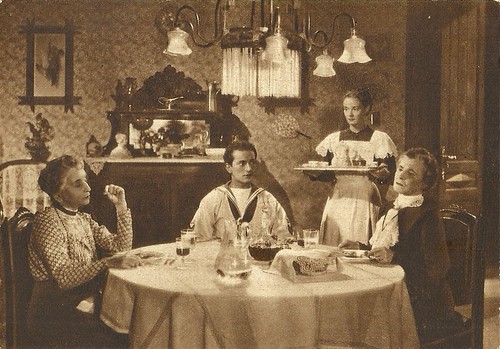
Italian postcard for Sissignora (Ferdinando Maria Poggioli, 1942), with María Denis, Emma and Irma Grammatica and Leonardo Cortese.
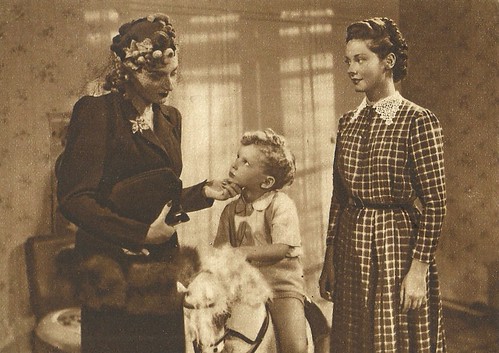
Italian postcard for Sissignora (Ferdinando Maria Poggioli, 1942), with María Denis, Evi Maltagliati and Silverio Pisu.
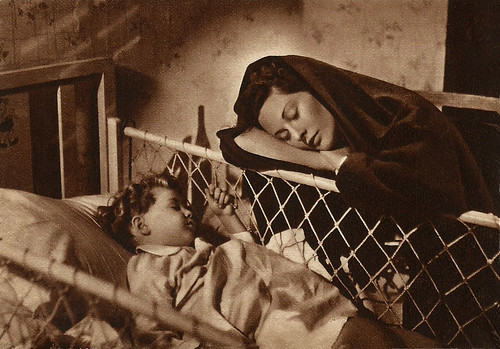
Italian postcard. Photo: ICI / ATA. Maria Denis and little Silverio Pisu in Sissignora (Ferdinando Maria Poggioli, 1942).
Sources: Wikipedia (Italian) and IMDb.

Italian postcard for Sissignora (Ferdinando Maria Poggioli, 1942), with María Denis.

Italian postcard for Sissignora (Ferdinando Maria Poggioli, 1942), with María Denis and Anna Carena.

Italian postcard for Sissignora (Ferdinando Maria Poggioli, 1942), with María Denis and Emma or Irma Grammatica.
Malice, narrow-mindedness, hypocrisy and egoism
María Denis plays in Sissignora young Cristina Zunio. She is an orphan after the death of her only aunt.
Cristina needs work and asks sister Valeria (Rina Morelli) for help. She thus becomes a domestic with the two old ladies Robbiano (Emma and Irma Grammatica) who treat her with austerity and narrow-mindedness.
Then their nephew, the young sailor Vittorio (Leonardo Cortese), returns from a long cruise. The two young people fall in love, opposed by the two old spinsters who won't accept he ties himself to a 'maid'. So they fire her to get rid of her.
Cristina thus starts working for the Bracco-Rinaldi family, who pretend to be high society but are debt-ridden, and they send Cristina away without payment. Meanwhile Vittorio manages to find Cristina and the two decide to marry, so Cristina rejects a marriage offer by the shy Emilio (Elio Marcuzzo), a young man from her native village.
But then sister Valeria conspires with the Robbiani ladies and demands Cristina to break with Vittorio, so he sails away. Alone again, she gets a job at signora Valdata (Evi Maltagliati), widow with a small boy (Silverio Pesu), whose 'cousin' around proves to be her lover. When the child falls ill, they charge Cristina to take care of it, without telling her it suffers from chicken pox, so she is contaminated as well.
It will be Emilio to help her, but too late. When a doctor orders Cristina to recover in hospital she is already dying and soon she blows her last breath. Malice, narrow-mindedness, hypocrisy and egoism have caused the death of the girl.
The novel on which the screenplay of Sissignora/Yes, Madam is based is called La servetta di Masone. It was serialised in the Genovese weekly periodical Il Lavoro between January and March 1940 in which Maria Steno, the author, wrote under the nom-de-plume of Vittoria Greco. Emilio Cecchi and Alberto Lattuada wrote the screenplay.
The film was shot in the Fall and Winter of 1941 at the Cinecittà studios and on location in Genoa for the exteriors. It was produced by Artisti Tecnici Associati (ATA), founded in 1937 by Carlo Ponti, and was distributed in Italy by Industrie Cinematografiche Italiane (ICI).The premiere was in 1942.
The film is unusual for the Italian cinema at the time, because the plot focuses on the maid. Actor Leonardo Cortese, cited by Wikipedia: "it was one of the first films that was shot on the streets." These realist locations were praised by many critics: a sense of truth emanates from those beautiful, external locations, like the markets between sea and rail, and the dance hall where maids and sailors meet in their free time. María Denis later said that for her Neorealism was born with Sissignora/Yes, Madam (1942).

Italian postcard for Sissignora (Ferdinando Maria Poggioli, 1942), with María Denis, Emma and Irma Grammatica and Leonardo Cortese.

Italian postcard for Sissignora (Ferdinando Maria Poggioli, 1942), with María Denis, Evi Maltagliati and Silverio Pisu.

Italian postcard. Photo: ICI / ATA. Maria Denis and little Silverio Pisu in Sissignora (Ferdinando Maria Poggioli, 1942).
Sources: Wikipedia (Italian) and IMDb.
No comments:
Post a Comment